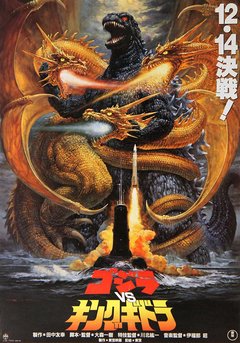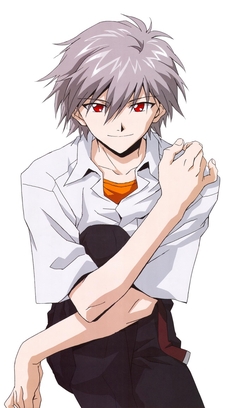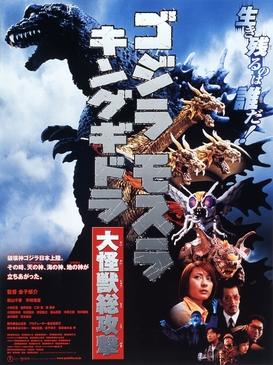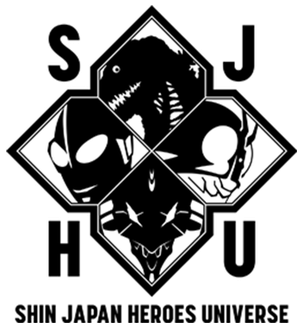
Godzilla vs. King Ghidorah is a 1991 Japanese kaiju film written and directed by Kazuki Ōmori and produced by Shōgo Tomiyama. Distributed by Toho and produced under their subsidiary Toho Pictures, it is the 18th film in the Godzilla franchise, and is the third film in the franchise's Heisei period. The film features the fictional monster characters Godzilla and King Ghidorah, and stars Kōsuke Toyohara, Anna Nakagawa, Megumi Odaka, Katsuhiko Sasaki, Akiji Kobayashi, Yoshio Tsuchiya, and Robert Scott Field. The plot revolves around time-travelers from the future who convince Japan to travel back in time to prevent Godzilla's mutation, only to reveal their true motives by unleashing King Ghidorah onto the nation.

Godzilla vs. Mothra is a 1992 Japanese kaiju film directed by Takao Okawara, with special effects by Kōichi Kawakita. Distributed by Toho and produced under their subsidiary Toho Pictures, it is the 19th film in the Godzilla franchise, and is the fourth film in the franchise's Heisei era. The film features the fictional monster characters Godzilla, Mothra, and Battra, and stars Tetsuya Bessho, Satomi Kobayashi, Takehiro Murata, Megumi Odaka, Shiori Yonezawa, Makoto Otake, Akiji Kobayashi, Koichi Ueda, Shinya Owada, Keiko Imamura, Sayaka Osawa, Saburo Shinoda and Akira Takarada, with Kenpachiro Satsuma as Godzilla. The plot follows Battra and Mothra's attempts to stop Godzilla from attacking Yokohama.

The Angels are fictional entities from the anime television series Neon Genesis Evangelion, which was produced by Gainax studio and directed by Hideaki Anno. The Angels also appear in the manga adaptation of the same name, which was illustrated by Yoshiyuki Sadamoto.

King Ghidorah is a fictional monster, or alien, or kaiju, which first appeared in Ishirō Honda's 1964 film Ghidorah, the Three-Headed Monster. The creature was initially created by Tomoyuki Tanaka, Eiji Tsuburaya, and Shinichi Sekizawa as an homage to the eight-headed mythological Japanese dragon Yamata no Orochi. Although the name of the character is officially trademarked by Toho as "King Ghidorah", the character was originally referred to as Ghidorah, Ghidrah, or Monster Zero in some English markets.

Shinji Ikari is a fictional character from the Neon Genesis Evangelion franchise created by Gainax. He is the franchise's poster boy and protagonist. In the anime series of the same name, Shinji is a boy abandoned by his estranged father Gendo after the mysterious death of his mother Yui. Years later, Gendo asks him to pilot a mecha called Evangelion Unit-01 to protect the city of Tokyo-3 from Angels, creatures which threaten to destroy humanity. Shinji appears in the franchise's feature films and related media, video games, the manga Petit Eva: Evangelion@School, the Rebuild of Evangelion films, and the manga adaptation by Yoshiyuki Sadamoto.

Rei Ayanami is a fictional character from the Neon Genesis Evangelion franchise, created by Gainax studio. In the anime series of the same name, Rei is an introverted girl chosen as the enigmatic pilot of a giant mecha named Evangelion Unit 00. At the beginning of the series, Rei is an enigmatic figure whose unusual behavior astonishes her peers. As the series progresses, she becomes more involved with the people around her, particularly her classmate and fellow Eva pilot, Shinji Ikari. Rei appears in the franchise's animated feature films and related media, video games, the original net animation Petit Eva: Evangelion@School, the Rebuild of Evangelion films, and the manga adaptation by Yoshiyuki Sadamoto.

Neon Genesis Evangelion: Girlfriend of Steel, also known as Neon Genesis Evangelion: Iron Maiden, is a video game based on the Gainax anime/manga series Neon Genesis Evangelion, released officially only in Japan for the PlayStation, Sega Saturn, PlayStation 2, PSP, Windows (PC), and Macintosh. On January 20, 2005, a legacy game titled Neon Genesis Evangelion: Girlfriend of Steel 2nd was released for the PlayStation 2. While it does feature much of the cast of the original game, the story is unrelated to the original's.

Kaworu Nagisa, real name Tabris, is a fictional character from the Neon Genesis Evangelion franchise created by Gainax. In the series, he is the pilot of a giant mecha named Evangelion Unit 02 for the special agency Nerv. Kaworu is the seventeenth and final member of the Angels which threaten humanity. When he arrives at Nerv, he meets Eva-01 pilot Shinji Ikari, showing great affection towards him. After revealing his nature as an Angel to Shinji, he asks him to kill him to allow humanity to survive. Kaworu appears in the franchise's animated feature films and related media, video games, the original net animation Petit Eva: Evangelion@School, the Rebuild of Evangelion films, and the manga adaptation by Yoshiyuki Sadamoto. He also has a prominent role in Evangelion: 3.0 You Can (Not) Redo, the third film of the Rebuild saga.

Godzilla, Mothra and King Ghidorah: Giant Monsters All-Out Attack is a 2001 Japanese kaiju film directed and co-written by Shusuke Kaneko. The 26th film in the Godzilla franchise and the third of the Millennium era, it serves as a direct sequel to Godzilla (1954), ignoring the events of every other installment in the series. Chiharu Niiyama stars as a reporter covering the story of Mothra, King Ghidorah, and Baragon defending Japan from Godzilla, a creature possessed by the souls of those killed during the Pacific War. The supporting cast includes Ryudo Uzaki, Masahiro Kobayashi, Hideyo Amamoto, and Shirō Sano, with Mizuho Yoshida as Godzilla, Akira Ohashi as Ghidorah, and Rie Ōta as Baragon.

Neon Genesis Evangelion: Shinji Ikari Raising Project is a life simulation computer game based on the anime series, Neon Genesis Evangelion. The player assumes control of both Shinji Ikari and Misato Katsuragi, the protagonists of the aforementioned anime series, to "raise" Shinji. This is done through making him complete a number of different tasks. Shinji Ikari Raising Project is the second and final entry in the Raising Project series of Evangelion games, preceded by Neon Genesis Evangelion: Ayanami Raising Project in 2001. Both games bear a strong similarity to publisher Gainax's Princess Maker series. The game was released officially in Japanese and Korean, and has received fan translations into English and Russian. The game was written by Nobuaki Takerube, and its artwork was drawn by Kengo Yonekura and Dream Japan Co., Ltd.

Neon Genesis Evangelion: Ayanami Raising Project is a simulation game created by Gainax and BROCCOLI, and based on the anime and manga series Neon Genesis Evangelion. The gameplay is similar to that of the Princess Maker series also developed by Gainax. It was released for Microsoft Windows PCs in 2001, and the Dreamcast the following year.

"Angel Attack" is the first episode of the anime series Neon Genesis Evangelion, created by Gainax. The episode was written by the series director Hideaki Anno and directed by Kazuya Tsurumaki. It was originally aired on TV Tokyo on October 4, 1995. The series is mostly set in the futuristic, fortified city Tokyo-3, fifteen years after a worldwide cataclysm named Second Impact. The protagonist is Shinji Ikari, a teenage boy whose father Gendo has recruited him to the organization Nerv to pilot a giant bio-machine mecha named Evangelion to combat beings called Angels. In the episode, Tokyo-3 is attacked by the Angel Sachiel, who fights the United Nations Army and the JSSDF. Gendo summons Shinji for the first time and Shinji reluctantly agrees to pilot the mecha.

"Rei II", also known by the Japanese title "Showdown in Tokyo-3", is the sixth episode of the anime Neon Genesis Evangelion, which was created by Gainax. "Rei II" was written by Hideaki Anno and Akio Satsukawa and directed by Hiroyuki Ishido. The series is set fifteen years after a worldwide cataclysm named Second Impact, and is mostly set in the futuristic, fortified fictional city of Tokyo-3. The episode's protagonist is teenage boy Shinji Ikari, who is recruited by his father Gendo to the organization Nerv to pilot a bio-machine mecha named Evangelion against beings called Angels. In the episode, Shinji must annihilate the fifth Angel Ramiel, who is able to destroy every enemy in its vicinity with an accelerated particles cannon. A plan called Operation Yashima is worked out, which involves Shinji shooting Ramiel from a distance with a Positron Rifle.

"Asuka Strikes!" is the eighth episode of the Japanese anime television series Neon Genesis Evangelion, which was created by Gainax. The episode, written by Hideaki Anno and Yoji Enokido and directed by Kazuya Tsurumaki, was first broadcast on TV Tokyo on November 22, 1995. The series is set fifteen years after a worldwide cataclysm and is mostly set in the futuristic, fortified city Tokyo-3. The series' protagonist is Shinji Ikari, a teenage boy who is recruited by his father Gendo to the organization Nerv to pilot a gigantic, bio-mechanical mecha named Evangelion into combat with beings called Angels. During the episode, Asuka Langley Soryu, a girl who is designated as the pilot of Evangelion Unit-02, is introduced; after the attack of Gaghiel, the sixth Angel, Asuka cooperates with Shinji aboard the Eva-02 to defeat the enemy.

Neon Genesis Evangelion is a Japanese manga series written and illustrated by Yoshiyuki Sadamoto and published by Kadokawa Shoten. It began in Monthly Shōnen Ace in December 1994 and later moved to Young Ace, finishing in June 2013. It consists of 14 volumes, each composed of several "stages" or chapters. It was initially released before the anime series of the same name by Gainax and Tatsunoko Production and was originally intended as a companion adaptation to that of the TV series.

Neon Genesis Evangelion: Battle Orchestra is a fighting video game produced by BROCCOLI. The game features Eva units and Angels from Neon Genesis Evangelion battling each other. The game is a platform fighter with fully 3D rendered backgrounds and environments. The Story Mode features individual arcs for Asuka Langley Soryu, Shinji Ikari, Tōji Suzuhara, Kensuke Aida, Rei Ayanami and Kaworu Nagisa. Every playable unit can also do two special attacks that unleashes a devastating attack.

Neon Genesis Evangelion: Campus Apocalypse is a Japanese manga series written and illustrated by Ming Ming based on the Neon Genesis Evangelion franchise. It was serialized in the shōjo manga magazine Monthly Asuka between 2007 and 2009, published by Kadokawa Shoten, and is also available in the PlayStation Store. It has been collected in four volumes.

Godzilla: Kaijū Daikessen is a 2D fighting video game released in 1994 for the Super Famicom. The game was developed by Alfa System and published by Toho. It was the second game based on Toho's Godzilla franchise to be released on Super Famicom, following 1993's Super Godzilla.

The Shin Japan Heroes Universe is a Japanese collaborative project between Toho, Khara, Tsuburaya Productions, and Toei. Developed by filmmaker Hideaki Anno, the project is intended for merchandise, special events, and tie-ins. It unites films that Anno had worked on that bear the katakana title "Shin" (シン).

Shin Godzilla, depicted as Godzilla in its film, is the titular main protagonist of the 2016 kaiju film of the same name directed by Hideaki Anno.




















